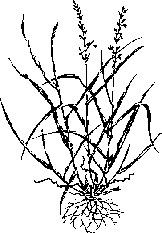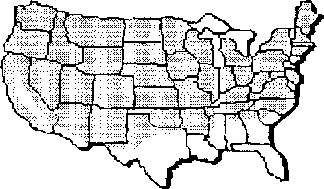In the United States, tall fescue is found from the Pacific Northwest to the southern states in low-lying pastures. Although it grows best in moist environments, tall fescue has good drought tolerance and will survive during dry periods in a dormant state. Tall fescue is adapted to a wide range of soils, but does best on clay soils high in organic matter. Tall fescue is well adapted to the "transition zone" of the United States where summers are too hot and humid for cool season grasses and winters too cold for warm season grasses. In the South, tall fescue is best adapted to those states in the transition zone - Oklahoma, Arkansas, Missouri, Tennessee, Kentucky, Virginia and northern parts of North Carolina, Georgia and Texas.

Description. The fescues (Festuca spp.) compose a large genus of about 100 species of grasses. Tall fescue (Festuca arundinacea) is a deep rooted, cool season perennial grass. The plant produces vigorous growth in the spring and fall and its extensive root system helps it withstand drought conditions. Tall fescue does produce short rhizomes but has a bunch-type growth habit - it spreads primarily by erect tillers. Individual tillers, or stems, terminate in an inflorescence, reach 3 to 4 feet in height, and have broad, dark green basal leaves. Leaf blades are glossy on the underside and serrated on the margins. The leaf sheath is smooth and the ligule is a short membrane. The inflorescence is a compact panicle, 3 to 4 inches long with lanceolate spikelets one-half inch or more long. The grass flowers in the spring and seed mature in early summer. Seed are 4 to 7 mm long, elliptic and awned.

Adaptation and Use. Tall fescue is adapted to a wide range of soil and climatic conditions, but performs best on well drained clay soils in the "transition zone." Tall fescue demonstrates good shade tolerance in the southern region and remains green year-round under irrigated conditions.
Mowing height requirements for tall fescue limits its use to lawns, parks, golf course roughs and other areas mowed at a height of 1.5 inches or more. Tall fescue should not be used where mowing heights are below 1.5 inches during summer months. Although its wear tolerance is considered good for cool season grasses, it is not nearly as wear tolerant as bermudagrass. Thus, it has limited use on golf courses and athletic fields in the South.
The improved turf-type tall fescues are finding widespread acceptance as lawn grasses in the transition zone. And, in the southern region under moderately shaded conditions, tall fescue is gaining in popularity. With proper management tall fescue can survive in densely shaded sites that warm season grasses cannot tolerate. Also, the improved tall fescues retain color during the winter months and provide a year-round green lawn.
Varieties. Kentucky-31 and Alta are the 2 oldest varieties of tall fescue in use today. Alta was selected from a stand of tall fescue in Oregon in 1923 and K-31 is an increase from tall fescue found in 1931 on a Kentucky farm where it had been growing for 50 years. Both of these grasses are coarse textured and produce a rather weak turf. They have been widely used as pasture grasses in the transition zone. Kenwell, Kenhy, Fawn and Goar were later releases, but possessed similar turf characteristics. In the 1970's, tall fescues were being developed specifically for turfgrasses and varieties such as Rebel, Olympic, Houndog, Falcon and Adventure were released. These new turf-type tall fescues are finer textured and produce a denser turf than older pasture-type varieties. They also provide year-round green color for lawns. Bonsai tall fescue is a newly released dwarf variety with outstanding turf quality.
A well prepared seedbed is essential for establishing tall fescue. A starter fertilizer can be worked into the seed bed prior to planting. The soil should be rototilled to a depth of 3 to 4 inches and firmed with a roller prior to seeding. The site must be well-drained so attention should be given to final grading of the site. Bermudagrass and some annual grasses are particularly troublesome in tall fescue turf. Steps should be taken prior to planting to eliminate these undesirable grasses. Tupersan can be used at the time of seeding to control crabgrass while non-selective materials such as glyphosate (Roundup) can be used to control bermudagrass prior to planting tall fescue.
The new turf-type fescues should be planted at 6 to 8 lbs. seed per 1,000 sq. ft. with a hydroseeder or mechanical seeder. Uniform distribution of seed is essential to develop a complete cover. Tall fescue is a bunch-type grass and is very slow to fill in spaces between plants. Germination of seed and survival of seedlings are improved when seed are lightly covered with soil and the seedbed firmed. Some planters perform both of these operations. Where seed is broadcast on the soil surface, rake the seed into the soil or cover lightly with topsoil or mulch.
Early fall is the optimum time to establish tall fescue from either seed or sod. Spring plantings of tall fescue may be successful, but the risk of losing immature plants to summer heat and drought stress is greater. Spring plantings of tall fescue are also more susceptible to Fusarium blight and other seedling diseases.
After seeding, keep the seedbed moist for 14 to 21 days to obtain maximum germination. Then, gradually reduce the frequency of watering. Begin mowing at a height of 2 inches when the grass reaches a height of 3 inches. Mow often enough so that the grass does not exceed the 3-inch height.
Approximately 1 month after planting tall fescue, apply a complete fertilizer at the rate of 1 lb. of nitrogen per 1,000 sq. ft. Tupersan can be used for preemerge control of crabgrass and other annual grasses in newly seeded and established tall fescue.
Management. Although tall fescue tolerates low fertility, it responds to fertilization, particularly nitrogen. About 3 lbs. of actual nitrogen per 1,000 sq. ft. per year are adequate for tall fescue. Apply a complete fertilizer according to soil test recommendations in the fall (September) and late spring (May) at a rate of 1 lb. of actual nitrogen per 1,000 sq. ft. Apply nitrogen alone at the same rate in February when the grass is actively growing. A summer application of 0.5 lb. of actual nitrogen per 1,000 sq. ft. may improve the color of the lawn. However, avoid overstimulation of the turf during summer months from excessive fertilization as this only adds to heat and drought stress problems. In shaded lawns, avoid summer applications of nitrogen.
Mow tall fescue at 2 inches during the fall and spring, raise to 3 inches in heavy shade and during the heat of the summer months. The improved turf-type varieties of tall fescue can be mowed at a height of 1.5 inches during spring and fall and 2 inches during summer months. Use a sharp rotary or reel mower and remove only one third of the leaf material per mowing. During peak spring and fall growth periods this requires mowing at 5-day intervals. If the lawn is mowed at the proper height and frequency, it is not necessary to remove grass clippings.
Proper watering is very important to the survival of tall fescue. Do not apply supplemental irrigation until the grass shows signs of needing water (wilting or rolling leaves). Then, apply enough water to wet the soil to a depth of 3 to 4 inches. If runoff occurs before the soil is moistened to a sufficient depth, turn the sprinkler off and allow the water to percolate into the soil. Then turn the sprinkler back on at a later time. Repeat this cycle until the soil is sufficiently moistened. Tall fescue requires frequent watering during summer months, which is one of the disadvantages to growing tall fescue in the southern region.
Tall fescue is fairly tolerant to most turfgrass diseases. However, Fusarium blight can cause extensive damage to young fescue lawns, particularly those planted in the spring. As the lawn matures, it appears less susceptible to attack by Fusarium blight. Leaf spot (Helminthosporium) and brownpatch (Rhizoctonia) can cause problems on older fescue lawns. Once the disease is properly identified, treat the lawn with recommended fungicides.
Major insect problems include armyworms, cutworms and white grubs. White grubs have been particularly damaging to tall fescue lawns. If white grubs are found in populations of 3 or more per sq. ft., treat with recommended products.
Many tall fescue lawns become thin after hot, dry summer conditions. A thinned tall fescue lawn forms clumps and becomes unsightly. To prevent this from occurring, it's usually necessary to overseed fescue lawns in the fall. Mow the lawn at a height of 1° inches before broadcasting seed. Rake the lawn to remove grass clippings and other debris. Apply starter fertilizer and seed at 2 to 3 lbs. per 1,000 sq. ft. These steps are usually adequate to rejuvenate the lawn. After seeding, keep the soil moist for 2 to 3 weeks.